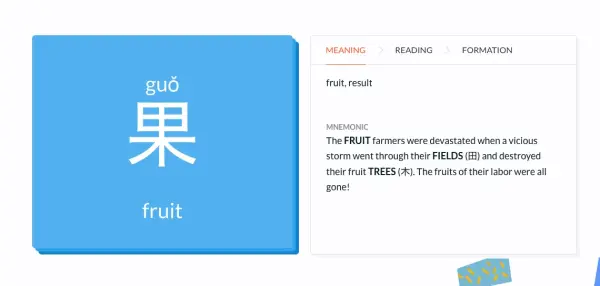
How to Memorize Chinese Characters: A Student-to-Student Guide
Have you just started learning Chinese and are wondering how many Chinese characters you will have to learn? How will you do it? Seems like an impossible task, right?
We've all been there, don't worry.
As a Chinese language student who managed to reach HSK6, this student-to-student guide is based on my experience studying and teaching Chinese, and it includes mobile apps and websites that will keep you company on your learning journey.
Top tips for memorizing Chinese characters
1. Learn the correct stroke order
I know what you're thinking: what's the point? A Chinese character only needs to turn out alright in the end. Well, not really.
Learning pinyin, tones, and Chinese sentence grammar feels overwhelming and never-ending, but trust me, you "wasting time" to learn the character’s stroke order is totally worth it.
If you don't, you'll have a harder time finding the character in the dictionary. Additionally, you won't learn how to write Chinese characters properly. Your characters will look too tall, short, fat, or get mixed up with other characters.

Stroke order for water in Chinese, EastAsiaStudent
Furthermore, your Chinese professor, and Chinese people in general, will somehow figure out that you got the stroke order wrong; I swear, it's like they have a built-in radar for that.
Over time the stroke order will reach your long-term memory and become automatic. You will be able to figure out which way to start writing, but please try to spend some time on it first.
2. Learn radicals
Radicals: if you haven't studied them yet, what are you waiting for?
Knowing the main radicals and how Chinese characters work will help you match a character to its meaning, making the learning process more meaningful and interesting.
Some radicals will help you link the character to its meaning, and others will help you link the character to its pronunciation—something very useful either way.

Chinese characters are made up of radicals
Similarly, with stroke order, it is worth "wasting" some time on this as an investment for the future.
3. Make learning characters fun
Study with a classmate, challenge each other, and assign a point system to the person who remembers the most characters or who has the nicest handwriting.
In other words, turn the writing process into a game to fight boredom. By focusing on the game, it makes writing much more fun. And you won’t risk going insane by writing a character 200 times on a sheet of paper, right?
You can combine learning characters with art and do some Chinese calligraphy. While you won't learn hundreds of characters, you will get to know your favorite ones perfectly, and you will get to observe them in every fascinating detail.
4. Don't learn random word lists
We are often handed lists of words to memorize, such as the list of words on HSK exams. Although this may sound very methodical, learning one word after another is not the best method.
To fix this problem, it is important to consider the word within a context. So practice writing sentences, not individual words.
Not only will you learn much faster, but you will also be able to use what you have. In the meantime, you will also be reviewing the characters you have already learned.
5. Don't consider character writing as "separate" from the rest of the Chinese language
There's no point in denying it; writing Chinese is the scariest part of learning the language.
When I tell someone, “I know Chinese,” one of the most frequent questions I get, usually coupled with a shocked expression, is: “So you know how to write Chinese characters?”
Some students tend to "put off" learning writing by learning to speak and listen first. But our brains don't like to learn that way!
Not only should writing go hand in hand with other skills, but you should do your best to practice it at the same time. Listen to a text and pronounce the character as you write it down.
When you think of a word, try not only to remember its sound but make an effort to imagine its shape. Use your hands and try to trace the character with your finger. Perhaps you will look weird, but I assure you that connecting your hand to your thoughts is the key to memorizing Chinese characters.
6. Make up your own techniques
We all function in different ways. Our brains operate through various patterns; there is nothing wrong with trying different learning styles.
The radical system is very useful and culturally significant. However, if it doesn't help you, try other methods. We don't all come to the same conclusion by the same methods.
If the shape of a particular radical will never remind you of its meaning, associate it with one that is meaningful to you. Look at the character's shape and try to think what the various parts remind you of.
Build a story using your ideas that will lead you to the true meaning and/or pronunciation of the character.
For example, 七 reminds me of an inverted 7. 八, like 8, is symmetrical. I don't think the ancient Chinese drew these characters with these ideas in mind, but it helps me remember them, and that's what matters.
When I first learned 语 I still didn't know the radical located on the left, which is a simplification of 言, meaning "language, word." It reminded me of the symbol for "information." Then I learned the correct definition. In the meantime, I attached the form of 语 to the concept of language in my brain. This association remained strong because it came from my own spontaneous mind associations.
So, you can do the same thing to associate Chinese characters with their pronunciation. For example, the character 风 means wind and is pronounced "feng." To remember the pronunciation, I imagined a gust of wind sounding like this: "feng."
My advice is not to be afraid to make up ways to remember, even if they don’t match the official definition. Learning is a personal and varied path, and it can arise from a combination of strategies.
A character memorized by following a different path will still result in your end goal. Rest assured, you will not have to remember your bizarre story every time; after a while, certain characters simply naturally come to you.
7. Write characters the old-fashioned way
We’re all used to typing on our PCs and phones, but to really learn how to write Chinese characters, pick up that pen and paper again.
Handwriting characters is very important. If you don't want to use too much paper, use an erasable board or a tablet. Anything that forces your hand to trace the shape of the character.
Even if you have to send messages, use hand input instead of typing with the pinyin keyboard. Writing Chinese characters by hand will take a little longer, but it will also help you memorize characters and their strokes. There is nothing worse than realizing you can read but can’t write. Keep in mind that recognizing a character and being able to write it are two completely different things.
Top 5 apps for memorizing Chinese characters
The best thing about phone apps is that you can use them wherever and whenever you want without needing a pen or paper. You will have everything right in your pocket!
Here are the top 5 favorite apps that I've used and still use, so I don't forget the characters:
1. Pleco
If you're studying Chinese and haven't installed Pleco yet, download it now. I discovered it after spending two months trying to use a very heavy dictionary, which would take me an hour to find five Chinese characters. The process almost drove me crazy.
With Pleco, you can look up Chinese characters by tracing them with your finger. This app will save you so much time.
But that's not all. On Pleco, you can create flashcard sets and find usage examples that will help you learn the characters in context.
By clicking on a character, you can see all the Chinese words it is part of, so you can learn more than one character at a time.

Pleco’s webpage
2. Chineasy
Chineasy is an eye-catching app with a very attractive design, which helps you learn Chinese characters by associating them with images in a very fun and stimulating way.
It can help you create new mental associations and make your studying less "gray." It looks like those colorful children's books.
It is a different app than the usual as it is ideal for artistic minds. There’s also a book, which is very interesting and beautiful to look at.

Inside Chineasy’s book, CoolHunting
3. Quizlet
On Quizlet, you can create your own flashcards by choosing what to write on each side. For example, Hanzi in the front and pinyin with its translation on the back. Also, you can add an image to strengthen your character memorization.
Additionally, you can also find flashcard sets created by teachers or other students, possibly using your same Chinese textbook.
Once you have created or saved a flashcard set, Quizlet will generate tests and games that you can do anytime and anywhere. For example, on the bus while listening to music is an efficient way to learn Chinese characters during your spare time.
4. Duolingo
One of the most popular language learning apps that most students already know.
Duolingo is a useful app that can help you practice characters, especially the most common ones for when you want to have fun and stay in touch with the language in less than 5 minutes.
Watch out because Duolingo's little owl will be offended if you don't practice every day. If tried Duolingo and is looking for an alternative, we got the perfect article for you: Need a Duolingo Chinese Alternative? Try These 4 Apps to Learn Chinese
5. Tandem
A useful app for learning Chinese and many other languages.
Tandem allows you to chat with native speakers, meet new people, and find answers to difficult questions through books.
After all, the best way to master a language is to communicate, and having a Chinese friend is a trump card.

Tandem's homepage
Top 5 websites for memorizing Chinese characters
Here are my five favorite Chinese learning websites that I have learned so many Chinese characters with.
1. Pandanese
A must-try web app for learning characters in an innovative and fun way.
Pandanese is the Chinese WaniKani, and it is based on one of the concepts that have been the key to remembering Chinese characters for me: the importance of stories and bizarre mental connections.

Learning Chinese characters with Pandanese's flashcard
The software was created by expert linguists based on intuitive and fun memory techniques, and I'm sure it will help you to build up and remember words in Chinese. You can use Pandanese online or log into the Pandanese App to learn on the go!
2. Yellowbridge
On Yellowbridge, you can find a dictionary with examples; for every character, you can see an animation displaying the stroke order.
Additionally, there is a detailed etymology of each character.
I mainly use this site to check the order of the strokes when learning new characters.

YellowBridge’s home page
3. MDBG
MDBG is a good dictionary that allows you to enter a complete sentence.
It also has a practice Chinese section where you can practice characters using flashcards and quizzes.
4. Yoyo Chinese
This site has videos, exercises, lessons, and quizzes to review at the end of each unit.
Yoyo Chinese allows you to learn at your own pace and is suitable for every level, from complete beginner to advanced learners.

Yoyo Chinese’s home page
5. YouTube
YouTube is a gold mine for doing anything and, of course, for learning Chinese characters and the Chinese language in general.
Search for videos relevant to you and watch them with Chinese subtitles so you can practice your listening comprehension and Chinese characters at the same time.
Many YouTube channels offer materials for all levels. My favorite is Mandarin Corner.

Mandarin Corner’s channel on YouTube
This channel has videos on current topics, stories, and interviews, as well as information about Chinese culture and language-learning tips. Mandarin Corner also has a website from which you can download extra materials.
There are also videos targeting the 6 HSK levels, with an example sentence for each Chinese word. You will definitely find the right video for you!
Frequently asked questions:
How to memorize Chinese characters:
Learn the correct stroke order
Learn radicals
Make learning characters fun
Don't learn random word lists
Don't consider character writing as "separate" from the rest of the Chinese language
Make up your own techniques
Write characters the old-fashioned way
How to learn chinese characters?
The best way to learn characters is to constantly use them. Whether in writing, speaking, or listening, being constantly exposed to any and all the characters will significantly improve your Chinese character proficiency.
In closing
These strategies kept me company over these long years and allowed me to reach and maintain a good level of proficiency in the Chinese language. I hope I have given you new ideas on how to memorize Chinese characters.
Do a combination of these learning apps, websites, sticky notes, pen, and paper to never get bored and improve every day. The most effective strategy is the one that makes sense and works for you! Unleash your imagination, and keep on trying.
加油!
Elisa Felici has been studying Chinese since 2014. She started her language-learning journey at Italian universities and lived in Beijing while attending Beijing’s Confucius Institute. Elisa passed HSK 4 and 5 and finally, in 2020, HSK 6. She now has a Master’s degree in translation and interpreting and has experience not only as a language learner but also as a Chinese teacher and translator.
The easiest way to learn Chinese & build vocabulary

